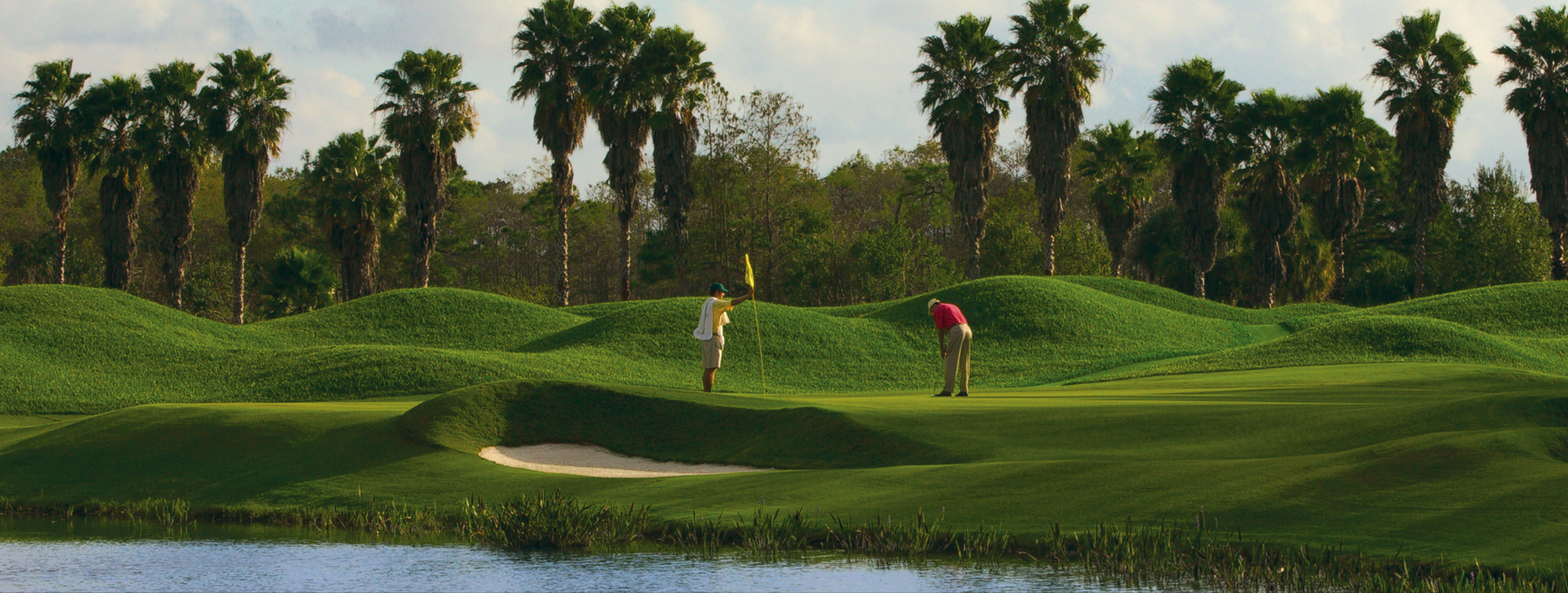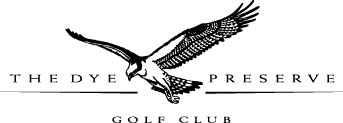
Winter 2017 issue of Florida Golf Magazine features "The Florida Golf Architecture of Arthur Hills" Click here to read it.

Written by Golf Course Designer, Pete Dye for Florida Golf Magazine
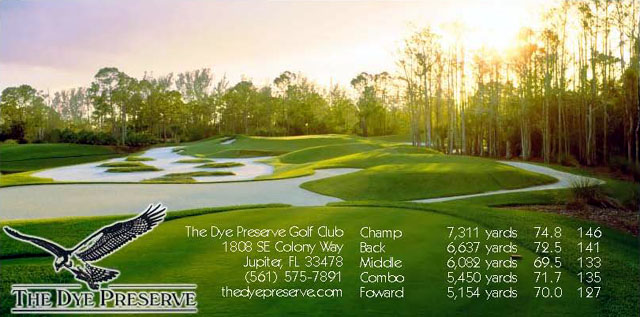 The 13th hole at The Dye Preserve Golf Club in Jupiter, Florida is an adaptation of the classic Redan Hole design at The North Berwick Golf Club in Scotland.
The 13th hole at The Dye Preserve Golf Club in Jupiter, Florida is an adaptation of the classic Redan Hole design at The North Berwick Golf Club in Scotland.
|
The Dye Preserve Golf Club Course Designer: Pete Dye, 1974 18 Holes, Par 72 |
||
|
Tees: Champ Back Middle Combo Forward |
Yards: 7,311 6,637 6,082 5,450 5,154 |
Rating / Slope 74.8 / 146 72.5 / 141 69.5 / 133 71.7 / 135 70.0 / 127 |

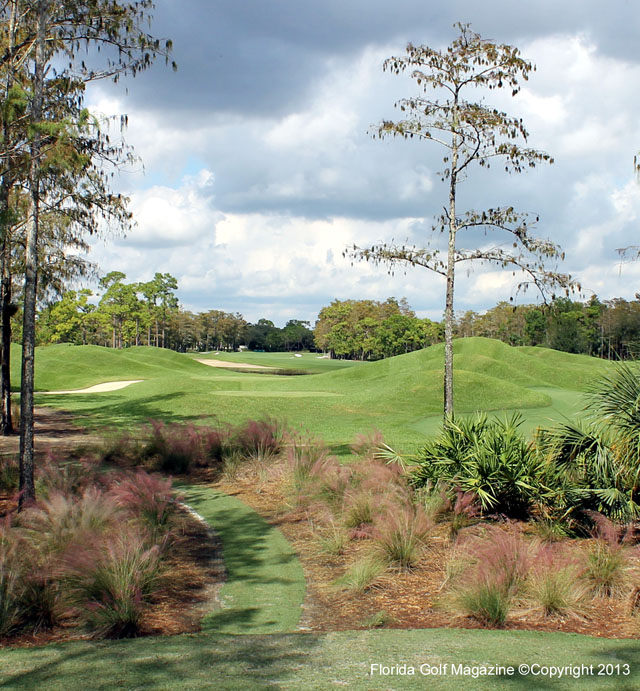 The tight Championship tee of the 508 yard par four 9th hole at The Dye Preserve. You can forget starting out way right with a big draw (right-to-left) because of the lone tree on the right. If this back tee seems too tight, you probably shouldn't be teeing off from back there.
The tight Championship tee of the 508 yard par four 9th hole at The Dye Preserve. You can forget starting out way right with a big draw (right-to-left) because of the lone tree on the right. If this back tee seems too tight, you probably shouldn't be teeing off from back there.
The Dye Preserve Golf Club, is a very special course I built just west of Jupiter, Florida. The club is the brainchild of the course managing partner, Joe Webster, a longtime developer and good friend. When he first bought the property there was a very-basic golf course already there that was said to have been originally designed by Gary Player. In 1988 I came in and rebuilt the golf course using the same routing. They called it Cypress Links, and it was a fine facility. Shortly thereafter, private club dynamics changed throughout Palm Beach County. In the early 1990s, an exclusive club membership in Palm Beach County could be had for five or ten thousand dollars. By the decade’s end that figure had skyrocketed to six figures.
My friend Joe Webster realized that to avoid being trapped in the bottom echelon of membership fees, and to be able to compete in a market going more upscale, he needed to start a whole new layout from scratch. So he called me in to once-again rebuild and this-time really enhance the golf course, and create an unforgettable setting that would help it to stand out dramatically in Palm Beach County’s golf-saturated environment. Without question, we accomplished this on the third iteration of this course.
Surrounded by thousands of acres of environmentally protected wood and grassland, The Dye Preserve is teeming with wildlife, and each of its 18 holes is unique and engaging and almost totally free of housing. We aimed at making a different kind of golf course at The Dye Preserve by giving the course a clean, well-defined look. South Florida is dead flat, so the golfer needs some help to see the shape of every hole from the tee. The fairways are wide, the greens are good-size, and water is in play, but usually adjacent to narrow waste areas or buffer zones of St. Augustine grass. The St. Augustine grass provides a look that screams “Old Florida” and does a wonderful job of framing and defining fairways throughout the course. Some say this hardy grass is tricky to hit out of, but I usually just play the ball a bit farther back in my stance to ensure clean contact and a reasonable advancement of the ball.

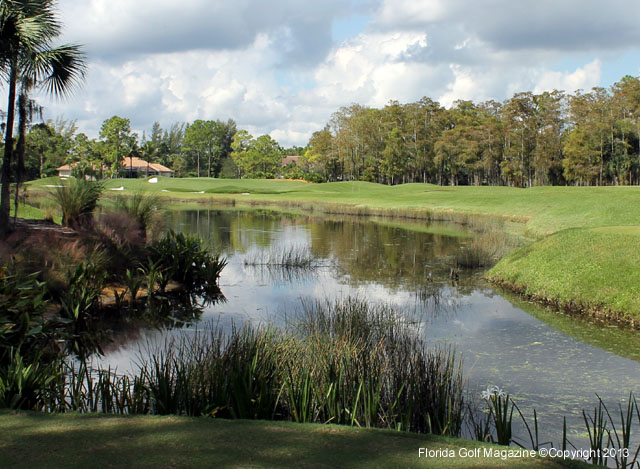 Longer, much lower and way left of the Back tee, the new "Way-Back" island tee of the 228 yard par three 13th hole was custom-made for the many Tour players that play at The Dye Preserve. To the right there are four elevated tees that are much closer and much higher. This tee is not for the faint-of-heart.
Longer, much lower and way left of the Back tee, the new "Way-Back" island tee of the 228 yard par three 13th hole was custom-made for the many Tour players that play at The Dye Preserve. To the right there are four elevated tees that are much closer and much higher. This tee is not for the faint-of-heart.
From our home in Gulf Stream, Florida it’s a short drive to The Dye Preserve and I really love going back and visiting now and then. The course has matured beautifully and the superintendent there really does a phenomenal job keeping the course in immaculate shape day in and day out. I especially like how over the years his maintenance crew has thinned-out and manicured the many cypress heads that surround the fairways. I also appreciate the way they’ve removed all the invasive exotic plants around the course. They’re policy is to plant only native trees and plants there and I think they’ve done a heck of a job recapturing the “Old Florida” look that I love so much.
In 2002, when we finished rebuilding the golf course, my friend Joe Webster felt that the brand-new course needed a brand-new name. And when he told Alice (my wife and design partner) and me that he wanted to honor us by calling it The Dye Preserve, Alice said, “You’ll never sell any memberships, don’t you know how many people curse my husband’s courses?” Well, she was half-kidding, of course, but in my own defense against the charge that many of my courses beat the average golfer half to death, I’d have to say that you’ll never hear me call the members at The Dye Preserve, average golfers. They are ardent golfers and are in a league of their own.
- Pete Dye
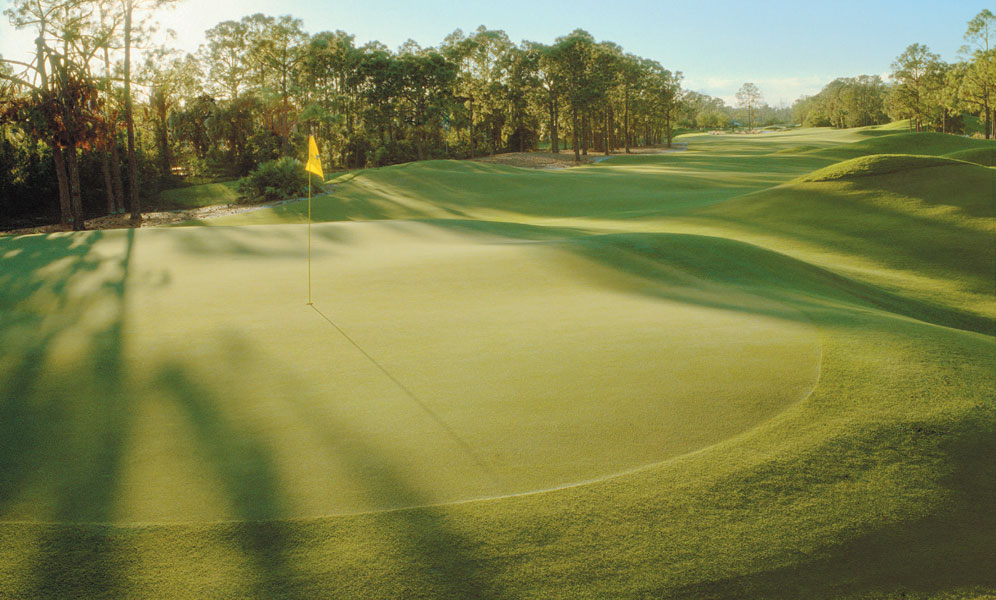 The par five 15th hole at The Dye Preserve Golf Club in Jupiter, Florida measures 543 yards from the back tees.
The par five 15th hole at The Dye Preserve Golf Club in Jupiter, Florida measures 543 yards from the back tees.

Pete Dye’s Design Notes: - The Dye Preserve in Jupiter, FloridaHole #1: Par 5, Hndcp 7, Champ 566, Back 538, Mid 480, Fwd 406You get a glimpse of the softer, more user-friendly character of the course at the Dye Preserve Golf Club on the mid-length par 5, first hole, which opens off the tee a little left to right. The cypress trees on either side of the fairway and the variety of grasses—TifEagle, paspalum and St. Augustine—provide definition. St. Augustine, a grass that Donald Ross used on the old South Florida Gulf Stream Golf Club course in 1923, frames every hole, and, in my opinion, is a grass that has been overlooked on many south Florida golf courses for a long time. Throughout the course there are beds of cypress mulch scattered on either side of the fairway, so if your ball gets in there, don’t worry; it will roll. Once you’re in the landing area, you’ll see that the hole sets off right to left, but there’s a lot of room for your second shot, especially to the right of the green. So stay to the right on your second shot. There’s a little lagoon on the left, but it should be out of play as long as you keep your ball right. The 1st green features two shelves with the front tier being higher than the back. This green is large for a par five, but as this is the opening hole: The object is to get you up and running. Hole #2: Par 4, Hndcp 13, Champ 366, Back 342, Mid 330, Fwd 284After playing a par five, this hole is a short almost dead straight par four that is best approached from the right side of the fairway to avoid a blind second shot. There are a couple of small bunkers if you get too far right with your tee shot, however, it’s still more open on the right side of the fairway than it is on the left. The backdrop to this golf hole is truly superb, and the St. Augustine grass makes it look like it’s going right to left off the tee. If you get a good drive, the green is wide open. We’ve done everything humanly possible to keep openings in front of all of the greens. Also, make sure you stay out of the bunker on the right side of the green, because a bad lie in there could cost you a few extra shots. Hole #3: Par 3, Hndcp 11, Champ 170, Back 163, Mid 154, Fwd 131The third hole is demanding and picturesque. If you play this par three from the proper tee, you shouldn’t have too long of a shot to the large green. It opens on the front right, and it’s got a little roll to it, but it’s fair. There is plenty of room to play golf on this hole, and there’s a lot of variation from the different tees. It plays 126 yards from the front tee to 170 yards from the championship tee. Be sure to use a half to a full club extra as the prevailing wind usually affects the tee shot on this hole. Hole #4: Par 4, Hndcp 1, Champ 467, Back 432, Mid 407, Fwd 319Hole #4 is justly rated as the number one handicap hole. I always try to come up with at least one par four that’s got some real length to it, and, believe me, this one does. It plays southwest—the prevailing wind being with you in the winter and against you in the summer. There is a big difference of 60 yards between the middle tee and the 467 yard championship tee. It’s a dogleg-right with plenty of room out there to get your ball in the fairway. The green is wide open in front, but you’ve got a few hungry-looking bunkers right and left, so just take that three or four wood, and hit your ball on up in there. There is water right of the green, but it should be out of play. On your second shot, notice the great background— the bunker, the green and a magnificent view of the Clubhouse, which is tucked away to the right and not directly behind the green. Strategically speaking, for the good players; a lefty like Phil Mickelson can play this hole because it’s left-to-right. However, most of the right-handed good players don’t like this dogleg-right because they mostly either hit it straight or right to left. So, from the championship tees they’re required to cut it (to-the-right) slightly, and that makes it harder for them. But for the higher handicap player who slices it no matter what happens, the 4th hole is not as hard for him as it is for the good player. Hole #5: Par 4, Hndcp 15, Champ 299, Back 281, Mid 261, Fwd 249Now, after playing the long difficult 4th hole we purposely shift gears, and made the next hole, #5 shorter and easier. The 5th hole is an interesting challenge for the good player as well as the higher handicap golfer, and in my opinion is the epitome of a risk-reward golf hole. If you’re brave enough to go for the green from the tee, your shot must not only avoid the water on the left, but you’ve also got to negotiate three fairway bunkers and one greenside bunker. You may miss the water, but still find par hard to obtain. The short, straight hitter should play to the middle of the fairway, and then hit a wedge to the green, for a shot at par. The left side of the green rolls off towards the water, but a small shelf at the water’s edge will hold a shot that has gently rolled off the green. The 5th green is relatively flat and should enable the player to make a good putt. Hole 6: Par 5, Hndcp 5, Champ 559, Back 529, Mid 481, Fwd 427I like the par five, 6th hole a lot because it plays a little stronger than the first par 5, and its bunkers are more severe. It is a straight-off-the-tee hole and much wider than it appears. Even if you let it fade off to the right on this hole you can still play your ball. Everyone can use their driver on this par five, so depending on the wind, you can get pretty close to the hole in two if you play from the proper tee. On your second shot, watch that bunker 100 yards or so short of the green. There’s plenty of room to bail out on the right side, so, you have an open shot, and it will give you a much better view of the green. There’s no water around the green, so the good player can gamble, however there are a few bunkers up there that might challenge him. But I love this green: It’s got a lot of size to it for a par five, and the rolls are very subtle. Hole 7: Par 3, Hndcp 17, Champ 216, Back 196, Mid 175, Fwd137There’s a bit of a walk from the sixth green to the seventh tee, but the beautiful cypress hammock on your right makes the walk worthwhile—don’t fail to notice it. This par three goes from 136 to 216 yards and runs a little right to left. The greenside bunkering is substantial, but I love the way this hole sets in there, and it’s got a great backdrop. For playability, number seven is a strong hole that requires a good tee shot. There’s not a lot of room for error, so pull out one of your better iron shots. The mulching around the seventh hole helps you not to lose your ball but it requires a different kind of shot; one unfamiliar to some golfers, however it’s still pretty easy to bounce it out of there and get it on the green. Hole 8: Par 4, Hndcp 9, Champ 387, Back 358, Mid 335, Fwd 285The eighth hole is a modest par 4, but when you stand on the back tee of this dogleg-right the landing area looks pretty small, but as you move towards the forward tee, you’ll notice that the hole looks much wider and there’s really plenty of room out there to hit your ball. After you’ve played this hole three or four times, it will begin to look more open. Keep your tee shot toward the left side of the fairway. Moving towards the green, you’ll notice how well the St. Augustine grass frames the hole. The cypress hammock on the right has been cleaned out considerably, so if you let one fly off to the right, you’ve got a good chance of finding your ball. You ought to have a short second shot on this hole, because the green is wide open in the front. There are a couple of bunkers on the left that guard the green and water behind, so stay right of them and you’ll be okay. Hole 9: Par 4, Hndcp 3, Champ 508, Back 448, Mid 418, Fwd 312Rated the 3rd hardest hole, the long par four 9th hole offers a lot of variety from the 312 yard front to the 508 yard championship tees—everybody’s got a shot. Players must hug the left side of the fairway so their approach shot is not blocked out by cypress trees on the right. But for the higher handicap golfers there’s plenty of room on the right even if you give it a little cut. As you approach the green, you’ll notice that the Clubhouse sits off to your left. You can sit in the Clubhouse and see the ninth green, yet when you play this hole; you’re not looking directly at the Clubhouse. One thing you can say about this golf course, the fairways are plenty wide, and on the ninth hole, the fairway ranges from 100 to 150 feet wide. You’re better off playing your approach shot straight down the middle of the fairway, because even though the green is wide open in front, its drastic contouring is liable to make the ball bounce one way or another. You don’t have to carry it there, because you’ve got a good chance of rolling it right onto the green, especially if you’re coming in a little bit left to right. Just stay away from the little bunker on the front right. Hole 10: Par 5, Hndcp 8, Champ 544, Back 514, Mid 478, Fwd 415From the back tee of the 10th hole, you feel like you’re coming out of a tunnel, and if you think it’s too narrow, you probably shouldn’t be playing from back there. But, this hole offers a great variety of nuances from the front to the championship tees, and it’s a great starting hole to the back nine—setting up left to right off the tee—the opposite of the first hole. There’s a great view of the 10th tees from the Clubhouse, and folks can see you teeing off, so hit a good one. From the 544 yard championship tee it’s a bit tighter, because 230 to 240 yards off the tee, there is a bunker on the left that comes into play. But from the 517 yard back tee you’ve got a clear shot. Take it easy and hit a good second shot down the middle. Another 40 yards or so is not going to help you a lot because it’s a long way to the green on this par five. The two-tiered green’s a pretty good size and opens right to left: It’s got a nice run off behind the green, but it’s not nearly as severe as it looks. Hole 11: Par 4, Hndcp 2, Champ 502, Back 468, Mid 434, Fwd 335I don’t believe that you can get a better long par four than Hole #11. Years ago, Donald Ross would often build a short par five like #10 followed by a long par four like #11 or vice versa. From the back tee, the tee shot on this double-dogleg sets up right to left, but from the front tee, it’s just the opposite. The fairway also kicks back left to right, giving you a fighting chance. The pine and cypress areas on the right are thinned out and surrounded by a bed of mulch, so if you slip a little off to the right, you can find your ball. The definition provided by the mulch and the St. Augustine sets up this hole nicely. You need a long second shot into the green on the 11th, but I want to emphasize that the green is wide open in front. From the fairway you can see the water and all the bunkering on the left, so keep your ball to the right. If you hit to the right, it’s going to kick in a little bit, so that’s not a bad shot at all. There is as much nature as you’ll ever see on this hole, making it hard to concentrate on your game, so don’t fail to notice it. The bunkering on the left side of the green is shallow, but the faces are pretty severe. I love this green. The front is wide open and it sets off right to left, and the contour around it falls in the same direction. This is a large green for a long par four, and it’s one of the few holes on the course I could lengthen if I had to, but I have yet to have anyone make such a request. As you walk off the green, you can’t help but notice the beauty behind it—the lagoon and the cypress trees—they are truly wonderful. So even if you don’t score well, I hope you enjoy the scenery. This is rated the 2nd hardest hole on the course, a four on this hole is a job well done. Hole 12: Par 4, Hndcp 10, Champ 426, Back 400, Mid 382, Fwd 307After playing two strong holes in a row, the tempo changes with the 12th hole which is rated as the easiest hole at The Dye Preserve. Looking at it from the tee, you’ll probably notice the greenside bunkers and the bunkering that frames the landing area also sets up the tee shot to be a little right to left. This hole also has a very long, shallow bunker framing the left side of the fairway. The fairway bunker on the right is out of play for most of us mortals, but a long hitter might reach the bunker on the right and wish he never had. There’s also a mound on the right side that will kick your ball back into the fairway, but ideally you want to stay a little left of the middle of the fairway. The green is wide open in the front and sets up a little bit left to right, and also runs off behind the green. You have two options here: You can either carry it onto the green or run it in. But stay out of those bunkers if you can, because they aren’t too kind, especially the one on the front right of the green. A back right pin placement is difficult to attack on this hole, while a front pin placement will allow plenty of birdie opportunities for all. Hole 13: Par 3, Hndcp 14, Champ 228, Back 198, Mid 182, Fwd 119This green is a redan-type green of about 7,000 square feet, with an elevation change from bunker to green of eight feet. The right side of a redan green that sets up right to left would normally be two feet higher than the left. However, with the speed of today’s greens, the slope on this green drops about eight to nine inches. Redan greens were first introduced in America during the 1920s by such great golf course architects as Donald Ross and Seth Raynor. This is as close to a true redan green as you will find in south Florida. With sand completely around the left and rear of the green and a bunker beyond a shelf of closely mown grass on the right, this green reads as a pseudo-island green. The tees are also elevated for a clear view of the green. The back tees, however, are a bit lower and to the left offering a slightly obstructed view of the green with an uphill carry of over 200 yards, and the 228 yard championship tees are more left and lower still. This is truly a classic golf hole. Hole 14: Par 4, Hndcp 16, Champ 376, Back 364, Mid 332, Fwd 293There is not a lot of length to the par four, 14th hole, and while I hate to brag, it sure has got a lot of character. This hole sets up left to right off the tee, then right to left to the green. That’s another old Donald Ross design trait. From the tee, giant pine trees define the right side of the fairway very nicely. Looking down at the first and second bunkers on the left side of the fairway and then at those down by the green, you will notice that they all have a different look to them. The bunkers on the left are severe enough to make you want to stay away from that side of the fairway and they also help to indicate that the green sits right to left. An accurate second shot is required to reach the open front of the elevated green that has bunkers both right and left and a collection area to the right. This is not an easy green to read and it has plenty of severity to it. Hole 15: Par 5, Hndcp 6, Champ 571, Back 543, Mid 476, Fwd 410When you stand on the tee of this hole, it is obvious that you’ve got to drive your ball toward the bunkers on the left. The definition of the fairway bunker on the left really turns this hole left to right going into the green. There are also a couple more bunkers just short of the green that turn the hole even more to the right. I think this hole sets up really well. But keep your ball on the left a bit because there’s more trouble on the right than there is on the left. There’s the little lagoon that goes down the right side, but you’ve got plenty of fairway if you just stay left. When you get up to the first landing area on this hole, you’ve got plenty of room and should get a flat lie. So rip it down there—give it a good shot—and go straight at the green. The bunker on the front left is pretty severe, so hit your ball in on the right side of it just a little. The green has nice contours, which are a little smaller than some, and the runoff and collection areas on both sides are also very playable. Hole 16: Par 4, Hndcp 18, Champ 384, Back 366, Mid 322, Fwd 303The 16th hole is a relatively short par four with a long bunker that stretches from the tee, down the left side of the fairway, to within 200 yards of the green. A smaller bunker—also on the left and just beyond the long bunker—guards the fairway along with a cross bunker on the right. With plenty of sand left and water on the right, this tee shot is visually intimidating. You’ve got three options off the 16th tee. First, you can play back to the widest part of the fairway short of the bunker on the right, leaving about 165 yards. Second, you can drive between the bunkers to a narrow fairway only 20 yards wide, leaving 130 to 150 yards in. Third, drive over the cross bunker and beyond the bunkers on the left between the lagoon on the right and the cypress trees on the left, leaving a rewarding approach of only 100 to 120 yards to the green. The bunkers around the 16th green are severe, but most are 18 to 20 feet away from the putting surface. The elevated green, with its closely mowed chipping areas, can kick an errant shot into one of the three deep bunkers that surround this green. There’s also a small pot bunker on the front right that is highly visible from the fairway. This hole is in a secluded area with many open views—the long view behind the 12th to the 13th hole just to name one, but it’s still very much an intimidating hole from tee to green. Hole 17: Par 3, Hndcp 14, Champ 240, Back 223, Mid 161, Fwd 124Everybody says that there should never be two hard par threes on any golf course; however, this is not the case on the back nine of The Dye Preserve. As you look from tee to green, the scenery is breath-taking—the lake along the entire right side of the hole, the bulkheading, and the cypress trees—all are truly spectacular. You’ve got all the length in the world here—probably more than you need. The tee area must be 10,000-square feet—I mean it’s enormous! So whomever you’re playing with, don’t let him put you on the wrong tee. If you want to lose a ball, just go on back to the 242 yard championship tee, but from the back or middle tees, it is truly a wonderful shot. The green sets in there left to right, so if you can just get over that little pot bunker in front of it, you’ll be okay. And then there’s the bunkering on the left side, which really sets off the look of the green. If you get in the one midway on the left side of the green, it’s got enough bank to give you a little test, especially if you’re shooting back towards the water. The green is big for this long par three, and there will be a few bogeys on this hole—maybe even a couple of doubles, but after a while you’re going to roll one up there and get a deuce. Hole 18: Par 4, Hndcp 4, Champ 454, Back 421, Mid 377, Fwd 305By the time you reach the 18th tee you should have a good feel for the course, but don’t get too comfortable. The lengthy par four 18th hole awaits each golfer’s finish to a superb day at The Dye Preserve. Setting up right to left, this great finishing hole is rated as the fourth hardest hole on the course. If you’re going to err, err a bit to the right. The front tee is far enough forward to give the ladies a fighting chance. And whether you drive or walk over the bridge onto the 18th fairway, you will get another sensational view of the Clubhouse. Here again, the hole sets up slightly right to left off the front and back tees. But when you get to the green, it sets up left to right. There is a variety of the bunkering about 100 yards short of the green. But there’s at least a 60-foot opening in front of the green, so I don’t know how it can get much better. If possible, try to stay out of the bunkers on the right, especially that little three-footer up there; if your ball lands in that one, it can really ruin your day. There’s plenty of room on the left side of the green, so if you hit a good one, you should make par. |

